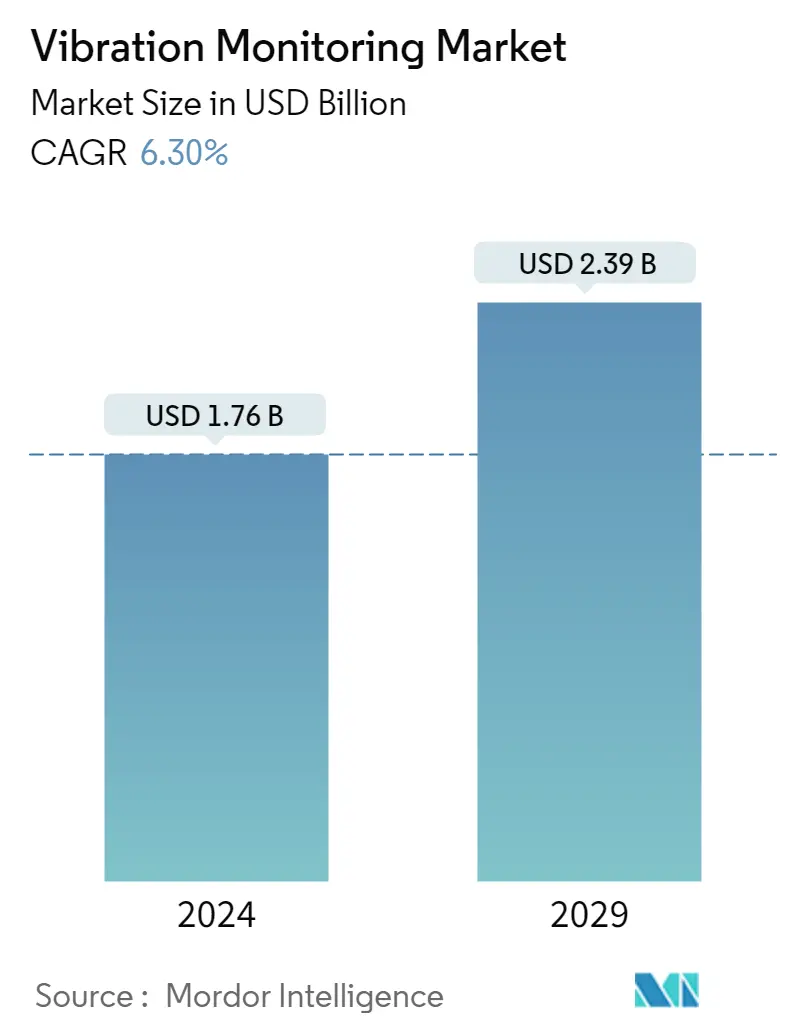Market Size of Vibration Monitoring Industry

| Study Period | 2019 - 2029 |
| Market Size (2024) | USD 1.76 Billion |
| Market Size (2029) | USD 2.39 Billion |
| CAGR (2024 - 2029) | 6.30 % |
| Fastest Growing Market | Asia Pacific |
| Largest Market | North America |
Major Players
*Disclaimer: Major Players sorted in no particular order |
Vibration Monitoring Market Analysis
The Vibration Monitoring Market size is estimated at USD 1.76 billion in 2024, and is expected to reach USD 2.39 billion by 2029, growing at a CAGR of 6.30% during the forecast period (2024-2029).
The machine maintenance industry has experienced growth due to the optimization potential of maintenance processes, which have become more streamlined than production processes.
- Vibration monitoring is a critical aspect of predictive maintenance, and it is primarily used in rotating equipment such as steam and gas turbines, motors, pumps, compressors, paper machines, rolling mills, machine tools, and gearboxes. It is used to evaluate the operational and mechanical condition of equipment. Vibration analysis can detect developing problems before they become too severe and cause unscheduled downtime, which can be achieved by continuously monitoring machine vibrations or at predetermined intervals.
- Vibration condition monitoring equipment measures the vibration levels of rotating and reciprocating machinery. Sensors collect information on frequency and amplitude to measure the vibration patterns of machinery. Vibration monitoring is essential for tracking and analyzing changes in the condition of machinery parts, such as gears and bearings, and predicting equipment or part failure.
- The introduction of advanced technologies and services associated with the Internet of Things (IoT) is transforming most industrial applications. The opportunities for new entrants and traditional players to offer innovative solutions that change the business models are created by initiatives aimed at the automation of factories and implementing industrial smart maintenance, as well as efforts towards creating more innovative working environments. The vibration monitoring market is expected to grow strongly, thanks to the use of condition monitoring for preventive maintenance.
- Industries such as chemical, oil and gas, power and petrochemical, cement, and pharmaceuticals must abide by the stringent international policies that dictate process efficiency, ergonomics, and employee safety. Many toxic gasses and chemicals, such as polyaromatic hydrocarbons, ethylene, benzene, propylene, hydrogen sulfide, butadiene, butane, and sulfur, are generated as byproducts during the manufacturing processes. Therefore, vibration monitoring is gaining momentum as employee safety has gained paramount prominence.
- This significance has pushed various verticals to make extra efforts to protect their machinery. The main benefit of fault identification using condition monitoring is to allow personnel to take remedial action to avoid or reduce repair costs and increase machinery safety, thus improving human safety. The growth of the market is anticipated to be driven by various key factors, such as the rising acceptance of wireless systems in machine condition monitoring, the rising popularity of automated condition monitoring technologies and smart factory penetration, and the emergence of secure cloud computing platforms utilized in condition monitoring.
- The market's overall growth could be improved by the presence of technical expertise. Additionally, the market faces limitations due to ethical considerations imposed by governing bodies and a need for proficient technological resources for practical data analysis. Moreover, the market is expected to encounter challenges throughout the projected period, including the unavailability of expertise in remote areas and the increasing trend of integrating vibration monitoring systems with other maintenance practices.
- There has been a significant increase in the demand for remote operations due to the COVID-19 outbreak. A major decline in revenue growth for a number of industry communication companies worldwide took place during the 1st quarter of 2020. With the continued recovery of the economy and the growing need for remote operations, the market is becoming more and more active, leading to the adoption of highly automated systems that do not require any human oversight.
Vibration Monitoring Industry Segmentation
Vibration monitoring is a fundamental concept in industrial machinery dynamic control. With the advancement of technology, current vibration monitoring systems that integrate complexity and performance can provide workers with comprehensive, near-real-time diagnostic information on the machines' actual dynamic state and implementation. Structural vibration monitoring is another market component that is extremely important as a target for business generation in the market for vendors.
The vibration monitoring market is segmented by type (hardware (displacement, velocity, and acceleration), software, and services), end-user industry (automotive, oil and gas, energy and power, mining, food and beverage, and chemicals), and geography (North America, Europe, Latin America, Asia-Pacific, and the Middle East and Africa).
The market sizes and predictions are provided in terms of value in USD for all the above segments.
| By Type | ||||||
| ||||||
| Software | ||||||
| Services |
| By End-user Industry | |
| Automotive | |
| Oil and Gas | |
| Energy and Power | |
| Mining | |
| Food and Beverage | |
| Chemicals | |
| Other End-user Industries |
| By Geography | |
| North America | |
| Europe | |
| Asia Pacific | |
| Latin America | |
| Middle-East and Africa |
Vibration Monitoring Market Size Summary
The vibration monitoring market is poised for significant growth, driven by its critical role in predictive maintenance across various industries. This market is increasingly essential for monitoring the operational and mechanical conditions of rotating equipment such as turbines, motors, and pumps. The integration of advanced technologies, including IoT and smart factory solutions, is transforming traditional maintenance practices, offering new opportunities for innovation and efficiency. Industries like oil and gas, power, and pharmaceuticals are particularly focused on vibration monitoring to enhance safety, comply with stringent regulations, and optimize operational efficiency. The market's expansion is further supported by the rising adoption of wireless and automated condition monitoring technologies, as well as the emergence of secure cloud computing platforms.
The oil and gas sector is expected to dominate the vibration monitoring market due to its need for predictive maintenance in extreme operating environments. The sector's focus on optimizing operations and ensuring safety aligns with the proactive measures offered by vibration monitoring solutions. Additionally, the power and infrastructure investments in regions like China and India are anticipated to drive demand for these technologies. The automotive and food and beverage industries also present growth opportunities, with increasing investments and a focus on preventive maintenance. The market is competitive, with key players like Rockwell Automation and Honeywell International actively expanding their offerings through partnerships and innovative product launches. These developments underscore the market's potential for sustained growth and the critical role of vibration monitoring in enhancing machinery safety and operational efficiency.
Vibration Monitoring Market Size - Table of Contents
-
1. MARKET INSIGHTS
-
1.1 Market Overview
-
1.2 Industry Attractiveness - Porter's Five Forces Analysis
-
1.2.1 Bargaining Power of Suppliers
-
1.2.2 Bargaining Power of Consumers
-
1.2.3 Threat of New Entrants
-
1.2.4 Threat of Substitutes
-
1.2.5 Intensity of Competitive Rivalry
-
-
1.3 Impact of Macroeconomic Trends on the Market
-
-
2. MARKET SEGMENTATION
-
2.1 By Type
-
2.1.1 Hardware
-
2.1.1.1 Accelerometer
-
2.1.1.2 Velocity
-
2.1.1.3 Displacement
-
2.1.1.4 Other Hardware
-
-
2.1.2 Software
-
2.1.3 Services
-
-
2.2 By End-user Industry
-
2.2.1 Automotive
-
2.2.2 Oil and Gas
-
2.2.3 Energy and Power
-
2.2.4 Mining
-
2.2.5 Food and Beverage
-
2.2.6 Chemicals
-
2.2.7 Other End-user Industries
-
-
2.3 By Geography
-
2.3.1 North America
-
2.3.2 Europe
-
2.3.3 Asia Pacific
-
2.3.4 Latin America
-
2.3.5 Middle-East and Africa
-
-
Vibration Monitoring Market Size FAQs
How big is the Vibration Monitoring Market?
The Vibration Monitoring Market size is expected to reach USD 1.76 billion in 2024 and grow at a CAGR of 6.30% to reach USD 2.39 billion by 2029.
What is the current Vibration Monitoring Market size?
In 2024, the Vibration Monitoring Market size is expected to reach USD 1.76 billion.

